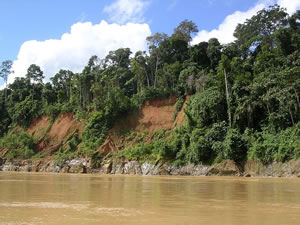Tropical rainforests are forests that have a hot, wet climate all year round.
Tropical rain and monsoon forests together occupy about 4.3 million square miles (11.1 million sq km), just over half the world's forests. About two fifths of this area consists of rain forests.
The Earth's three main regions of rainforest can be found around the equator. They merge into monsoon forests in the north and south.
 Unlike the monsoon forest, where the climate has a fairly marked dry season, the tropical rainforest is always hot and humid.
Unlike the monsoon forest, where the climate has a fairly marked dry season, the tropical rainforest is always hot and humid.
The steamy heat is ideal for plant growth, and it is possible to find more than 100 different types of big trees on a single acre.
Some species are common, but a few are so rare that they may be known only from a single tree.
Trees make the framework of the forest, with the biggest commonly reaching a height of 150 feet (45m). The giants have trunks reminiscent of cathedral columns, which are often fluted or buttressed at the base. Beneath them are medium-sized trees. On the forest floor, miniature trees, only a few feet tall, live permanently in deep shade.
The forest interior, occasionally flecked by sunlight, is open and easy to walk through. Along roads and rivers, however, the edge of the rain forest is a dense tangle of sun-loving climbers. Big, woody climbers hang down within the forest, each with a crown as big as a small tree at the canopy top.
Other shade-loving climbers cling to tree trunks: those of the lower levels, many of which are ferns or aroids, may have huge leaves.
Epiphytes, plants that grow on other plants and have no connection with the ground, depend on the forest frame. Some species are adapted to the moist, dark forest interior. Others, especially orchids, are sun-loving, and drape limbs and boles of trees in the top canopy.
Another characteristic of the tropical rainforest is that it provides a habitat for many animals - ground-dwellers and tree-dwellers. This animal diversity is further enhanced by interdependence with plants.
Flowers may be specialized for pollination by birds, bats or insects. Many fruits are adapted for animal-dispersal. Some mammals are attracted to the plants' bright hues and strong smells: birds to their vivid, contrasting hues: bats to trunk- or branch-borne flowers and fruits; and fish to fleshy fruits hanging over streams.
Plants that are familiar in cooler parts of the world as small herbs exist as huge trees in the tropical rainforest. Tree violets can reach 80 feet, and milkworts grow even taller.
Some plants, such as nutmegs and Brazil nuts, can only survive in the hot, wet rainforest environment.